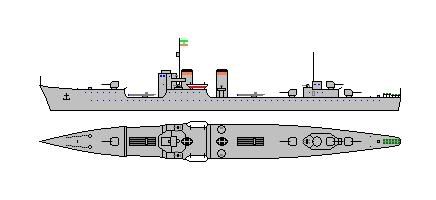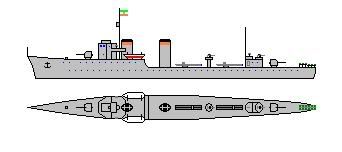
Urumi, laid down 1925
Length, 203.0 m x Beam, 22.6 m x Depth, 6.2 m
14629 tonnes normal displacement (13030 tonnes standard)
Theoretical Air Group: 40
Main battery: 6 x 15.0-cm (2 x 3; 1 superfiring)
Secondary battery: 8 x 10.5-cm
AA battery: 8 x 3.5-cm
Light battery: 4 x 1.5-cm
Weight of broadside: 415 kg
4 TT, 50.0 cm (submerged, aft)
Main belt, 8.0 cm; ends unarmored
Upper belt, 8.0 cm
Armor deck, average 5.0 cm
Conning tower, 8.0 cm
Battery armor:
Main, 10.0 cm / secondary, 5.0 cm shields
AA, 2.0 cm shields / light guns, 2.0 cm shields
Maximum speed for 78005 shaft kw = 32.01 knots
Approximate cruising radius, 15000 nm / 12 knots
Typical complement: 665-865
Estimated cost, $13.275 million (£3.319 million)
Remarks:
Superfiring turret is aft.
Main turrets are grouped together.
Relative extent of belt armor, 98 percent of 'typical' coverage.
Ship has slow, easy roll; a good, steady gun platform.
Ship is roomy, with superior accommodation and working space.
Distribution of weights:
Percent
normal
displacement:
Armament ......................... 114 tonnes = 1 pct
Armor, total ..................... 2438 tonnes = 17 pct
Belt 1015 tonnes = 7 pct
Deck 1145 tonnes = 8 pct
C.T. 41 tonnes = 0 pct
Armament 238 tonnes = 2 pct
Machinery ........................ 3394 tonnes = 23 pct
Hull and fittings; equipment ..... 5091 tonnes = 35 pct
Fuel, ammunition, stores ......... 1967 tonnes = 13 pct
Miscellaneous weights ............ 1625 tonnes = 11 pct
-----
14629 tonnes = 100 pct
Estimated metacentric height, 1.2 m
Displacement summary:
Light ship: 12662 tonnes
Standard displacement: 13030 tonnes
Normal service: 14629 tonnes
Full load: 15849 tonnes
Loading submergence 2946 tonnes/metre
+++++++++++++++++++++++++
Estimated overall survivability and seakeeping ability:
Relative margin of stability: 1.14
Shellfire needed to sink: 8089 kg = 172.4 x 15.0-cm shells
(Approximates weight of penetrating
shell hits needed to sink ship,
not counting critical hits)
Torpedoes needed to sink: 2.0
(Approximates number of 'typical'
torpedo hits needed to sink ship)
Relative steadiness as gun platform, 70 percent
(50 percent is 'average')
Relative rocking effect from firing to beam, 0.12
Relative quality as a seaboat: 1.09
+++++++++++++++++++++++++
Hull form characteristics:
Block coefficient: 0.51
Sharpness coefficient: 0.35
Hull speed coefficient 'M' = 8.33
'Natural speed' for length = 25.8 knots
Power going to wave formation
at top speed: 54 percent
Estimated hull characteristics and strength:
Relative underwater volume absorbed by
magazines and engineering spaces: 97 percent
Relative accommodation and working space: 177 percent
Displacement factor: 125 percent
(Displacement relative to loading factors)
Relative cross-sectional hull strength: 1.00
(Structure weight per square
metre of hull surface: 528 kg)
Relative longitudinal hull strength: 1.03
(for 6.00 m average freeboard;
freeboard adjustment +1.02 m)
Relative composite hull strength: 1.01
+++++++++++++++++++++++++
[Machine-readable parameters: Spring Style v. 1.2.1]
665.84 x 74.13 x 20.34; 19.68 -- Dimensions
0.51 -- Block coefficient
1925 -- Year laid down
32.01 / 15000 / 12.00; Oil-fired turbine or equivalent -- Speed / radius / cruise
1625 tons -- Miscellaneous weights
++++++++++
6 x 5.91; 2; 1 -- Main battery; turrets; superfiring
Central positioning of guns
Superfiring turret aft only
:
8 x 4.13; 0 -- Secondary battery; turrets
Gun-shields
:
8 x 1.38 -- Tertiary (QF/AA) battery
Gun-shields
:
4 x 0.59 -- Fourth (light) battery
4 / 4 / 19.69 -- TT / submerged / size
++++++++++
3.15 / 0.00 / 3.15 / 0.00; 98 -- Belt armor; relative extent
1.97 / 3.15 -- Deck / CT
3.94 / 1.97 / 0.79 / 0.79 -- Battery armor
(Note: For portability, values are stored in Anglo-American units)
+++++++++++++++++++++++++++++++++++++++++++++++++++++++



Quoted
Hey - are you guys seeing pics for G-143 and T-19? Because I'm not, and the image script in my posts says that I should be...Quoted
G-143's still using the old German/Japanese destroyer lay-out. I'd be curious to know if there's any data out there on how this layout worked...